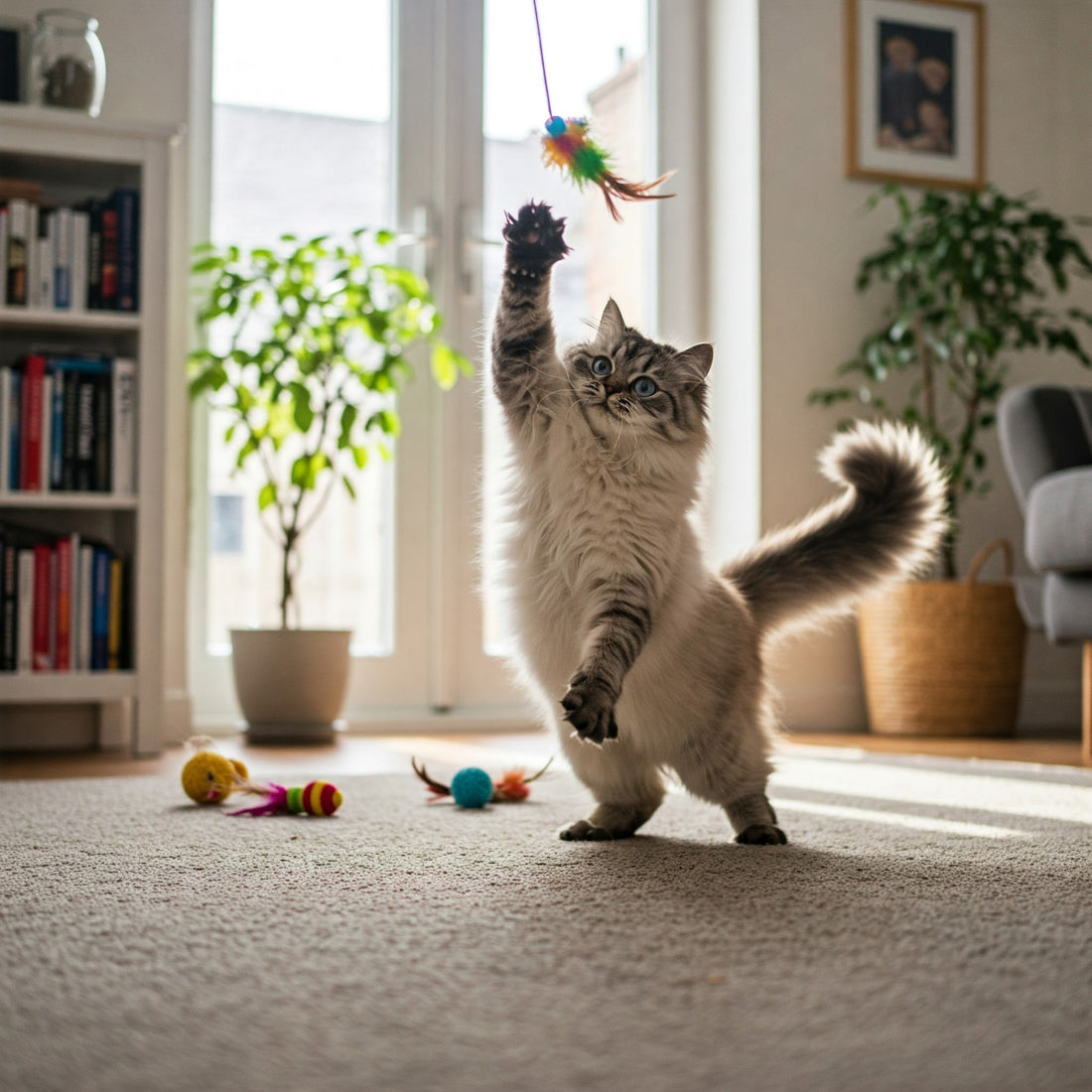
The Best Indoor Cat Playgrounds: Keeping Your Cat Active at Home
Share
For indoor cats, the world can sometimes feel small and uneventful. Without the natural stimulation of outdoor exploration, hunting, and climbing, cats confined to the indoors may struggle with boredom, weight gain, and even behavioral issues. This is where a well-designed indoor playground becomes essential—not just as a luxury, but as a fundamental part of their physical and mental well-being. Cats are natural athletes, hunters, and explorers, and when these instincts go unfulfilled, the consequences can range from lethargy to destructive habits. An engaging indoor playground recreates the challenges and adventures of the wild in a safe, controlled environment, allowing cats to climb, hide, pounce, and observe their surroundings from the heights they naturally crave.

Is Your Cat Bored Indoors? Here’s How to Fix It
The foundation of any great indoor cat playground is vertical space. In nature, cats climb trees to hunt, escape predators, and survey their territory. Indoors, this translates to cat trees, wall-mounted shelves, and perches that allow them to ascend and claim their domain. A tall, sturdy cat tree with multiple platforms provides exercise as they jump from level to level, while also giving them a sense of security as they watch over their kingdom from above. Some cats prefer wide, stable perches where they can sprawl out, while others enjoy cozy cubbies where they can curl up and nap. The key is to offer variety—different heights, textures, and vantage points keep their environment dynamic and interesting. For homes with limited floor space, wall-mounted shelves or walkways can create a thrilling climbing circuit without taking up valuable real estate.
Scratching is another instinctive behavior that must be accommodated in any indoor playground. Cats scratch to mark territory, stretch their muscles, and maintain their claws. Without appropriate surfaces, they’ll inevitably turn to furniture, carpets, or curtains. A good playground integrates multiple scratching options—vertical posts for full-body stretches, horizontal pads for those who prefer to scratch while lying down, and angled scratchers that mimic the angle of tree bark in the wild. Sisal rope, corrugated cardboard, and natural wood are all excellent materials that satisfy the urge to scratch while protecting household items. Placing scratchers near favorite resting spots or along common pathways encourages frequent use, reinforcing good habits.

Hiding spots are just as important as climbing structures. Cats are ambush predators by nature, and they love having enclosed spaces where they can retreat, observe, or launch playful attacks. Tunnels, whether store-bought or homemade from cardboard boxes, provide endless entertainment as cats dart in and out, peek around corners, or lie in wait for an unsuspecting toy (or human foot). Covered beds, igloo-style hideaways, or even strategically placed blankets draped over furniture create cozy sanctuaries where cats can relax undisturbed. Some cats prefer high hideouts, like enclosed perches atop cat trees, while others enjoy ground-level nooks where they can feel safely concealed. The more options available, the more confident and content a cat will feel in their environment.
Interactive elements transform a static playground into a dynamic adventure zone. Toys that mimic prey—feather wands, motorized mice, or crinkly balls—trigger a cat’s hunting instincts, encouraging stalking, chasing, and pouncing. Puzzle feeders or treat-dispensing toys add mental stimulation, turning mealtime into a rewarding challenge. Many cats enjoy batting at hanging toys or fishing-pole-style lures that dangle from shelves or cat trees, providing independent play when humans aren’t available to join in. Rotating toys every few days prevents boredom, as cats are more likely to engage with “new” items than ones they’ve grown accustomed to seeing. Even simple household objects, like crumpled paper or empty boxes, can become sources of fascination when incorporated thoughtfully.

For multi-cat households, a well-planned playground helps prevent territorial disputes by providing ample resources. Cats are solitary hunters but often live in social groups, and conflicts can arise when they compete for space, perches, or hiding spots. Having multiple climbing routes, separate scratching posts, and several cozy retreats ensures that each cat can find their own preferred spot without tension. Some cats prefer to observe from a high perch, while others might claim a low, enclosed bed as their safe zone. By designing a playground with enough variety and duplicate resources, owners can minimize competition and create a harmonious living space.
The best indoor playgrounds also consider a cat’s need for mental engagement. Window perches or bird feeders placed outside provide hours of entertainment as cats watch the world go by—a form of “cat TV” that satisfies their curiosity about the outdoors. Some owners install fish tanks (with secure lids) or even videos of birds and squirrels on tablets to captivate their feline audience. These passive entertainment options are especially valuable for cats left alone during the day, offering mental stimulation even when active play isn’t possible.
Safety is a critical factor in any playground design. All structures should be sturdy and stable, able to withstand enthusiastic jumping and climbing without wobbling or tipping. Securely anchored wall shelves, heavy-base cat trees, and non-slip materials prevent accidents. Avoid small, detachable parts that could become choking hazards, and ensure that any electrical cords (like those from automated toys) are safely tucked away. Regular inspections for wear and tear—loose screws, frayed ropes, or weakened platforms—help maintain a safe environment over time.
For those who enjoy DIY projects, creating a custom cat playground can be a rewarding way to tailor the space to a cat’s unique preferences. Repurposed bookshelves, floating wooden planks, or even old ladders can be transformed into climbing structures with a little creativity. Cardboard boxes can be stacked into forts or connected with holes to form tunnels. The advantage of homemade playgrounds is the ability to adjust sizes, heights, and configurations to perfectly suit a cat’s personality and the home’s layout. However, for those less inclined to build, there are countless high-quality commercial options ranging from compact condo-style trees to sprawling, multi-tiered jungle gyms.
The placement of the playground within the home also influences how much it will be used. Cats like to be where the action is, so positioning climbing structures or perches near family gathering spots—like the living room or home office—encourages interaction and engagement. A cat tree by a window offers both a view and sunlight for basking, doubling its appeal. Even in small apartments, clever use of vertical space can create an enriching environment without cluttering the floor.
An indoor playground isn’t just about physical activity—it’s about fulfilling a cat’s natural instincts in a way that keeps them emotionally balanced. A cat that can climb, scratch, hide, and hunt within their home is a cat that feels secure, stimulated, and satisfied. This leads to fewer behavioral problems, better physical health, and a stronger bond between pet and owner. Observing how a cat interacts with their playground can also provide insights into their preferences, helping owners refine and expand the setup over time.
Ultimately, the best indoor cat playground is one that evolves with the cat’s changing needs. Kittens may crave high-energy play and daring leaps, while senior cats might prefer lower platforms and softer resting spots. Regularly introducing new elements—a different type of scratcher, a novel toy, or a rearranged shelf—keeps the environment fresh and engaging. By investing time and thought into creating a stimulating indoor playground, owners can ensure their feline companions lead happy, active, and fulfilling lives—all within the safety of home.
